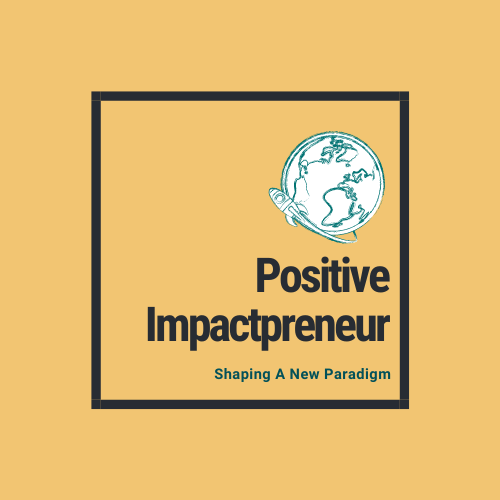Your impact-driven service and support organisations can be a transformation catalyst for the impact sector
If you offer business services, training & education, or sector development, this is for you:
You can be an Impact Sector Catalyst. As such, you create mechanisms that can speed up the transformation process of organsiations and the entire sector exponentially. Instead of pushing harder, you know how to lower the barriers to change. You understand leverage points and develop solutions that have impact on multiple levels - individuals, organisations and systems. As an Impact Sector Catalyst, you understand and use the ingredients for catalytic change.

A Paradigm Shift Is Far Away
We can not deny it: there is a yawning gap between the new paradigm we urgently need and the harsh reality of a polycrisis. Vision and reality are lightyears apart. The transformation to a new economy is going too slow.
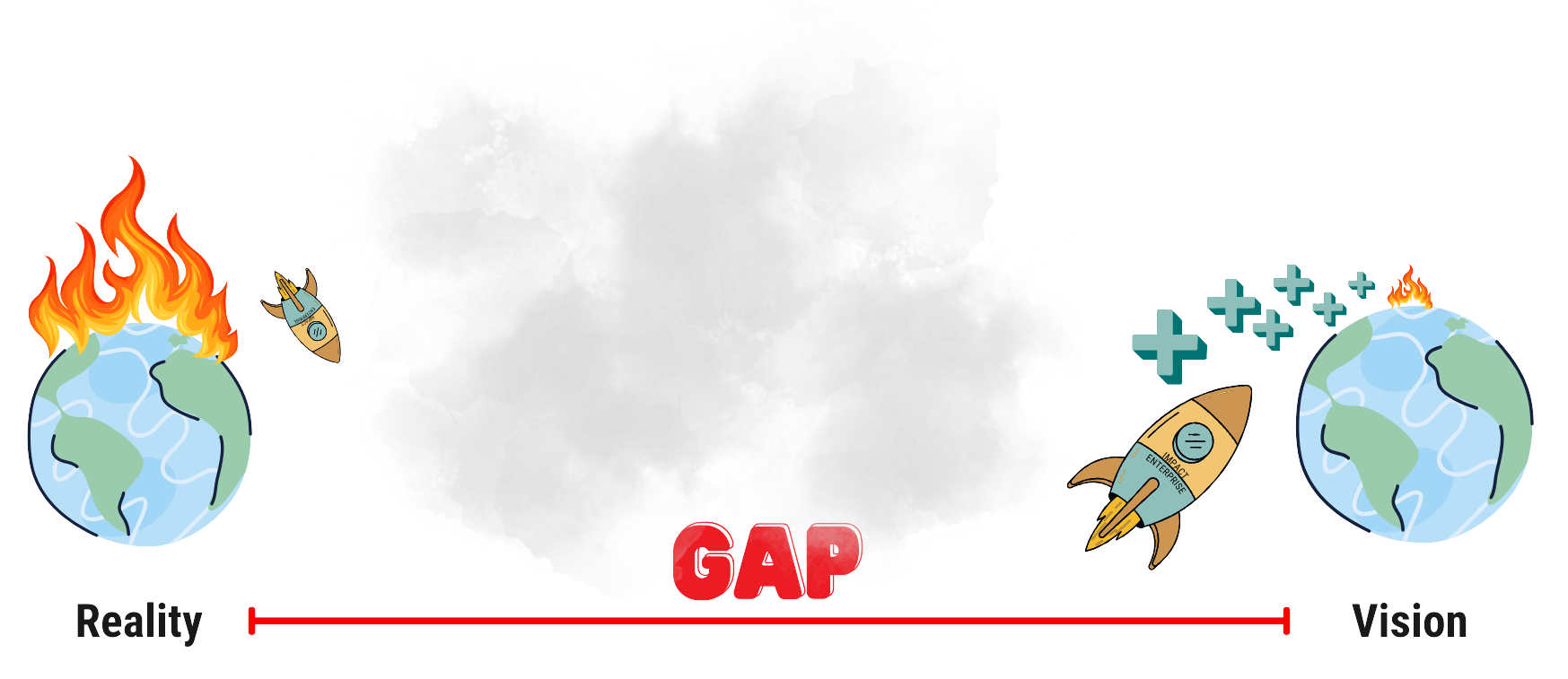
Structures and systems are broken. We have created an economic system that crosses planetary boundaries and exploits people. Businesses play a critical role in this dynamic.
We need a paradigm shift in business and the economy. But the transition is going slow.
The solutions are there, BUT...
The impact sector is highly fragmented and cohesion is missing. Solutions don't find their way to large scale application. While we know what needs to be done to address many of the pressing problems, there is an impact action gap.
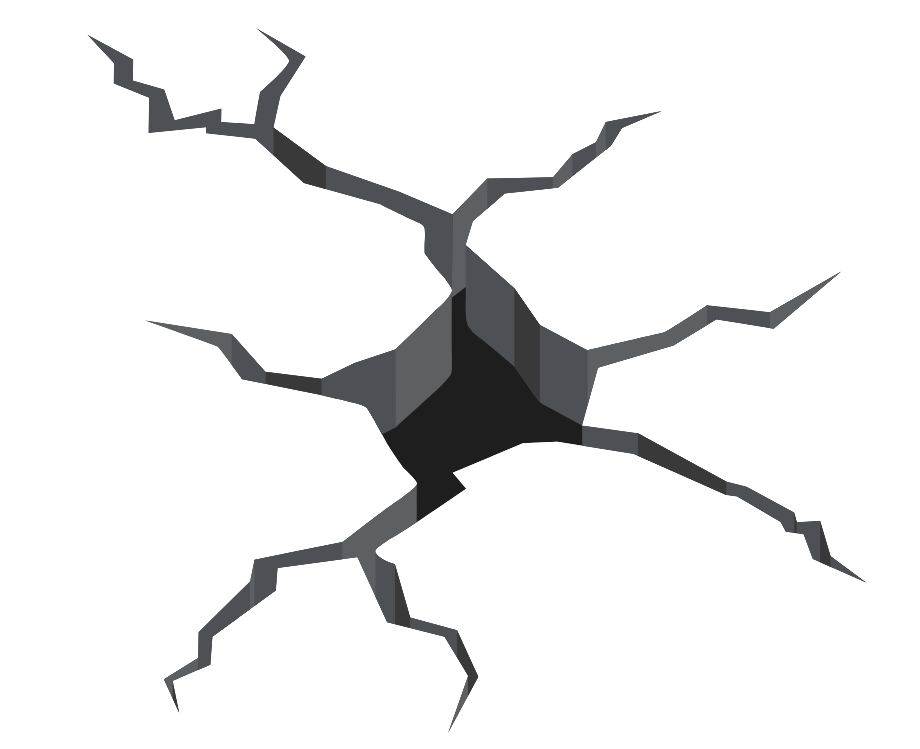
The impact sector has many faces: sustainability, regeneration, responsible business, conscious capitalism, B Corp, Social Entrepreneurship, impact investing, and many more.
The 'impact sector' is an umbrella term that encompasses all movements and activities for good.
Missing: An aligned supportive ecosystem
Every sector needs an aligned supportive ecosystem to function and to unfold its potential. As the impact sector is in its infancy, the supportive ecosystem of the impact sector is even more fragmented and weak. Without support, impact enterprises, solutions and initiatives are kept from surviving, thriving and scaling.
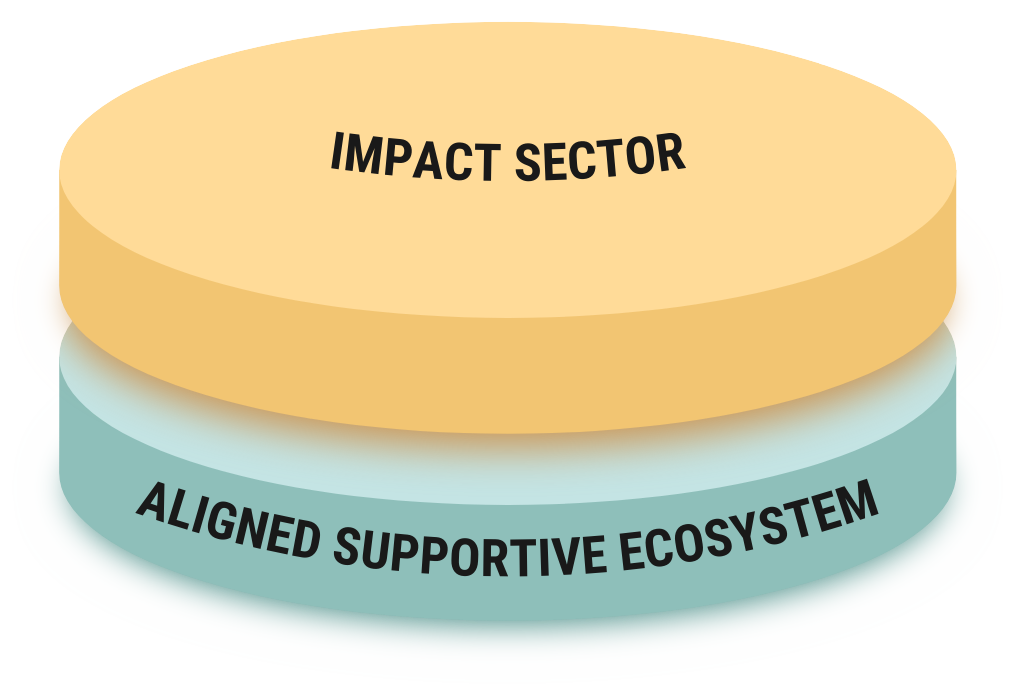
A supportive ecosystem consists of various aspects: aligned labour market and talent, knowledge, capital, training and education, and aligned support services and intermediaries, among others.
A lack of aligned business and support services is particularly concerning.The sector is stiffled.
You Are The Secret Sauce To The Sector
As a support organisation that offers business services, training and education or sector development, YOU have expertise and services that are crucial for impact sector development. You are the secret sauce to many initiatives, projects and organisations.
You Offer Business Services
You advise, consult or offer agency services i.e. on Impact Strategy, ESG Topics, Sustainability, Ethical Marketing, Impact Measurement, Purpose, etc.
You Deliver Education & Training
You provide training, sprints, workshops or programs i.e. on Responsible Leadership, Regenerative Business, Social Enterprise Building, etc.
You Drive Sector Development
You drive sector development by doing i.e. advocacy, policy development, research, sector network building and representation, etc.
The impact sector holds the solution to many of the pressing problems we face. If we don't accelerate impact sector development, we can never outpace the pressing problems of our time.
Without a strong supportive ecosystem, impact sector development will not accelerate.
But Despite All Your Efforts, It's Like Sticking Bandaids
Despite your valuable services and aim for big picture change, the reality is that you can often only treat 'old paradigm' symptoms and that there is a scope mismatch between the size of the problems and what you can do and contribute to with your services.

This can be frustrating, because you see the relevance of your work for business transformations, innovation, capacity building, problem-solving, representation, and more.
You, your expertise and services are the invisible glue to many projects and initiatives.
Slow Change Is Not Your Fault,
Your Organisation Is Facing Major Barriers
If you are like most impact-driven service and support organisations, you are facing major barriers that keep you from creating a large-scale ripple effect or making systemic change. The problem is: you operate on a small scale with very limited resources.

While you do what you can, things don't add up fast (enough) and it feels like you are tilting windmills. More often than not, you get bulldozed by daily business operations and project work.
A limited number of small-scale, isolated projects is what you are most probably looking at.
Problem Is: Your Impact Might Be Limited
You can only serve a very limited number of clients at any given time or implement a very limited number of inititives. No matter how much more you work on customised, isolated projects, this will not address the pressing problems on a larger scale.
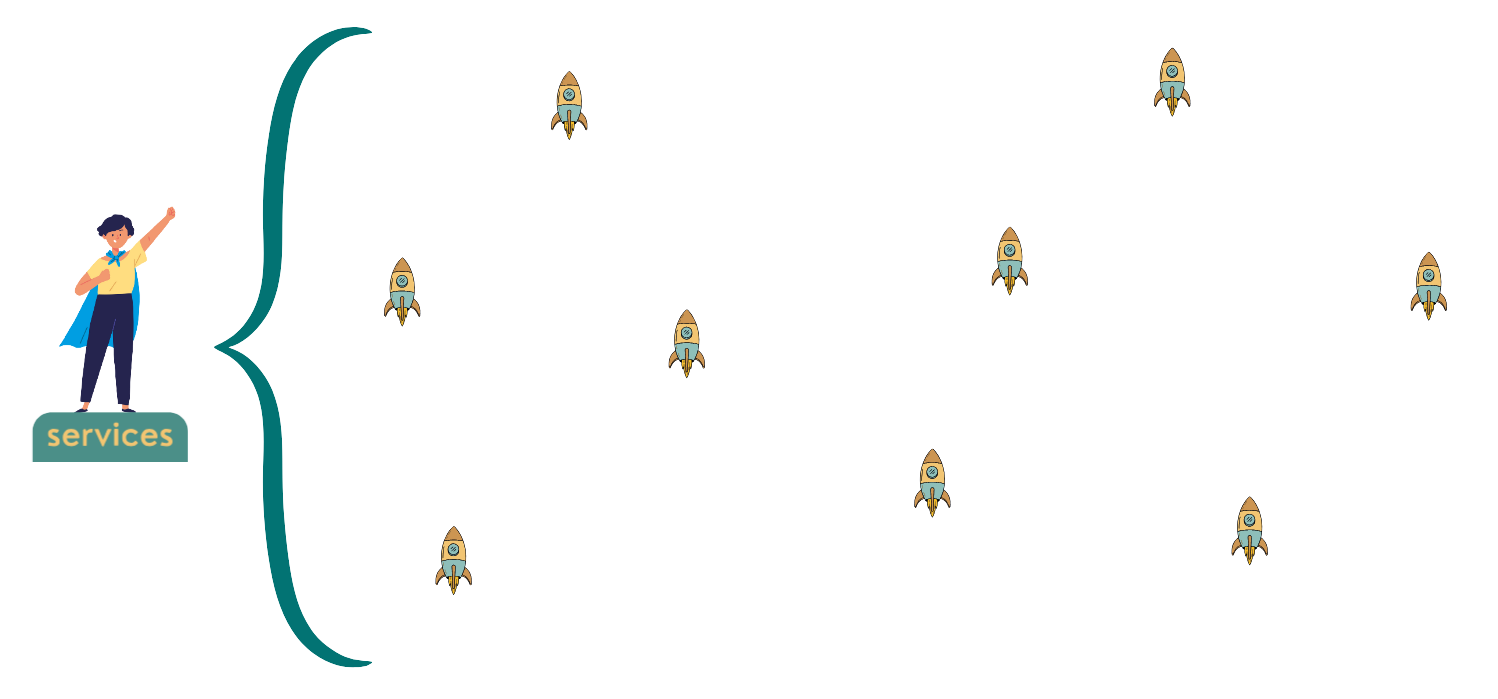
The ugly truth is this: many impact-driven actors are hoping that small-scale efforts, their own and those of others, will magically come together to a larger change. They will not.
More projects and pilots will not lead to a larger, systemic effect. This is not how it works.
Impact (And Revenue) Are Capped
Your service-based business depends on the amount of skilled people and the number of hours in the day available for projects that make an impact. There is a natural limitation within service work. Just doing more of it will not drive large-scale impact.
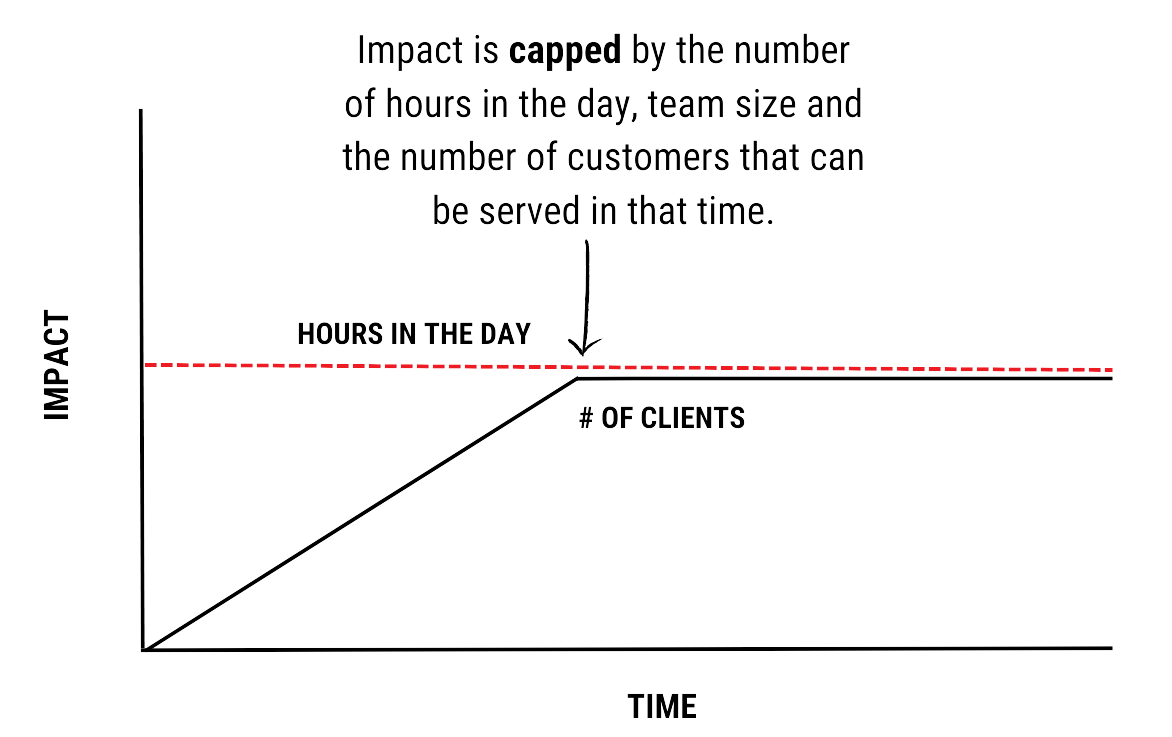
The approach and vehicle of a service business are not made for large-scale, systemic change. While important, they will not close the massive gap or accelerate sector development.
There are major barriers that keep most service-based businesses capped.
Service Businesses Face 11 Common Barriers To Large-Scale Change
If you identify TWO OR MORE within your organisation, you are stuck in the service firm trap.
-
Barrier #1: Small-Scale Focus
Most support organisations have a service business model. Projects have a high degree of customisation and are delivered in 1-on-1 settings so that only a limited number of projects can be handled simultaneously. Since time and people are finite resources, there is a natural cap on impact and revenue. In addition to billable hours, there are also many support activities that absorb time and capacity.
-
Barrier #2: Impact-Revenue Tension
Impact-driven intermediaries and service providers often struggle to achieve financial sustainability while supporting other impact organisations. Especially those that focus on serving others in the sector (i.e. Social Enterprise) face the problem that these organisations have limited access to capital and a low ability-to-pay. That is why many intermediaries (i.e. accelerators, incubators, capacity-building programs) depend on donations and grants as their major income source. More commercially-driven support organisations on the other hand, often lack sufficient impact focus which can lead to impact-washing and merely cosmetic change.
-
Barrier #3: Symptom Treatment
Many customers don’t look at the big picture and have limited time and budget for their projects. Instead of delivering end-to-end transformations that change the overall system, service and support organisations are forced to scale solutions down and fit them into formats that alleviate symptoms. Many projects are driven by an immediate customer pain and ‘what can be sold’ rather than systemic change. This can be frustrating as it feels like treading water.
-
Barrier #4: Overloaded Portfolio
Financial necessity can lead to saying 'yes' to many different requests ending up with a long menu of different services. Organisations spread themselves thin when they try to do it all and can easily become a jack-of-all-trades. Because of a broad portfolio of topics, they often start from scratch with each new project and have high set-up costs. In short, they lack a clear profile.
-
Barrier #5: Opportunistic Development
Many support organisations operate driven by opportunities in their network and have developed organically over time. They get recommended or offered follow-up work that evolves naturally, often leaving these organisations with scattered results. Accepting various different projects can be due to scarce resources and financial necessity.
-
Barrier #6: Expert Dependency
The business model is knowledge-intensive and expertise-based, which means experts deliver the services to create value for your customers. Often, these experts are the drivers of their customers’ organisational development and are required for projects to progress and get results. The expert becomes the bottleneck and often an unhealthy dependency is developed. This can lead to projects dying when handed over to the customer and a lack of agency among employees.
-
Barrier #7: Delivery Bind
Employees and leaders are busy working in the business to deliver the work and forget to work on the business. Projects and client work eat up all resources and are the main focus. This can even lead to a gap between projects, if acquisition and filling the pipeline is neglected. It can also lead to outdated offers and becoming ‘one of many’ organisations that cannot be distinguished from other players in the market.
-
Barrier #8: Non-Tech Business
Many service providers have shifted their service delivery online for pure survival to continue to serve their customers during the pandemic. This way, they have been able to keep the business running. But this was a reactive coping mechanism, not a strategic decision for digitalisation. It rarely went beyond virtual live delivery and often ended in online fatigue. After the pandemic, many organisations are back to offline delivery and neglect their digitalisation efforts altogether. They don't see themselves as tech-enabled businesses and have a low digital maturity.
-
Barrier #9: Situational Action
Every employee handles inquiries based on their best ability. There are no specific guidelines and many activities depend on key persons. If a key person is absent or leaves, there can be a severe knowledge loss or even an inability to operate. Vital information is locked away in the heads of individuals or stored on their personal computers, inaccessible to others. A lack of transparency and systems can therefore pose a high risk and result in a lot of wasted time.
-
Barrier #10: Manual Activities
Many business activities are done manually and need people, expertise and time to be implemented. This is very resource-intensive. Low digital maturity and a lack of systems and processes does not allow for automation. Plus, repetitive tasks as well as administrational activities can occupy highly skilled employees as they have the process knowledge and more junior staff don't. When done by different people, the quality of results can also fluctuate and lead to inconsistency.
-
Barrier #11: Individual Depletion
Being involved in wicked problems and the pressing challenges of our time day in and day out can take a toll on people. Your focus is on the well-being of people and planet, over which you can forget your own well-being. Personal depletion and feeling drained can be a result of doing the important work in the impact sector. On top of that, facilitating people, their dynamics and deep transformation processes is intense and requires a lot of energy. Many people in the sector burn out before they can make a large-scale change at all.
Now you know what is standing in your way. That is the first essential step. But the question is: what will you do with these insights?
You've Got Three Choices Now:
1. Do nothing: Stay stuck on a plateau
While the dream is to create big picture change, you get stuck in prevailing conditions. Limited capacity due to a lack of skilled employees, the current economic crisis or failed attempts to productise leaves the company on a plateau in terms of impact and revenue. From there, you haven’t moved for months, and you might stay stuck there for years.
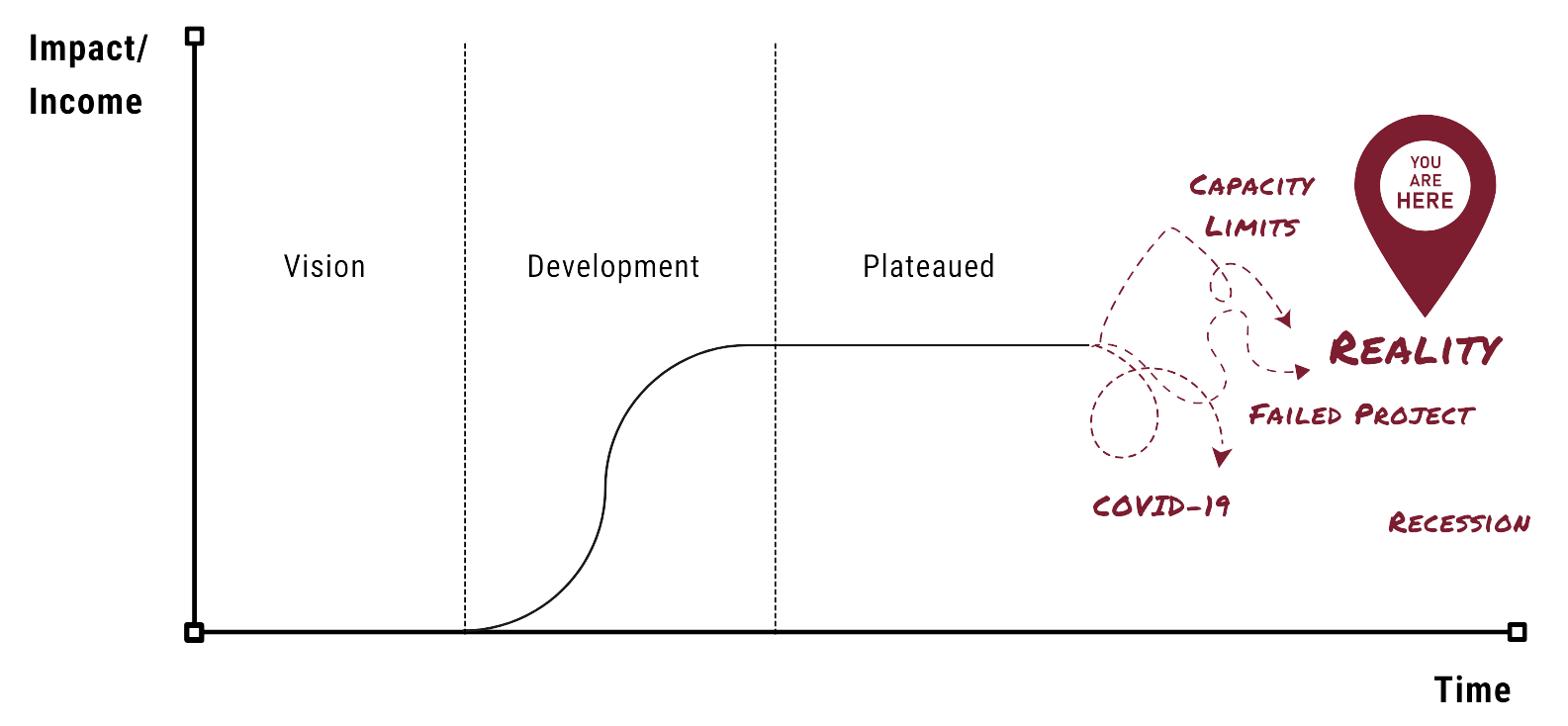
2. Take the slooow path: Build a team
The usual way to increase impact and revenue for a service firm is to grow slowly. This means a slow process of adding new team members and acquiring more projects. So, for every additional output in impact and revenue (usually additional projects) there are increased costs because additional skilled people are needed. The intended growth is marginal, since every new client and project also increases expenses significantly. You fall into the trap of wanting large-scale impact but going for snail-pace growth.
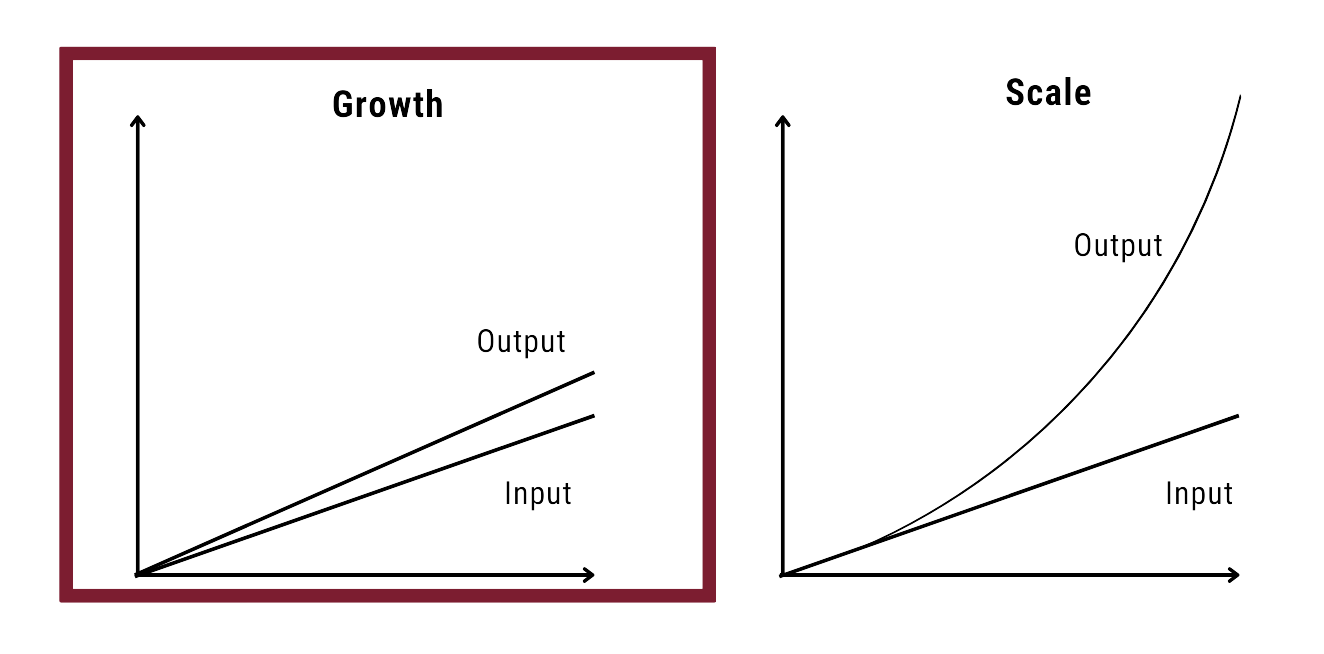
Plus, something else can happen if you are the owner/ CEO: you love doing ‘the work’ (i.e. training, consulting, facilitating, coaching, etc.) and you never wanted to do all the management and leadership tasks and be occupied with the administrative and organisational aspects that come with running a growing organisation. All of a sudden, you can find yourself in a role you didn't even want.
3. OR you can make a bold choice instead:
Your impact-driven service and support organisations can become a transformation catalyst for the impact sector
Impact Sector Catalysts know how to create a mechanism that speeds up the transformation process of organsiations and the entire sector exponentially. Instead of pushing harder or trying to convince people, they lower the barriers to change. They understand leverage points and develop solutions that have impact on multiple levels - individual, organisational, and system. Impact Sector Catalysts know and use the ingredients for Catalytic Change.

Many Ripples To A Wave Of Change
As an impact sector catalyst, you create various ripple effects simultaneously at any given point in time that ultimately compound to a wave of transformation independent of the number of people and hours you have available. Instead, you are using a mechanism for catalytic change. The program gives you access to the entire, research-backed framework for catalytic change.
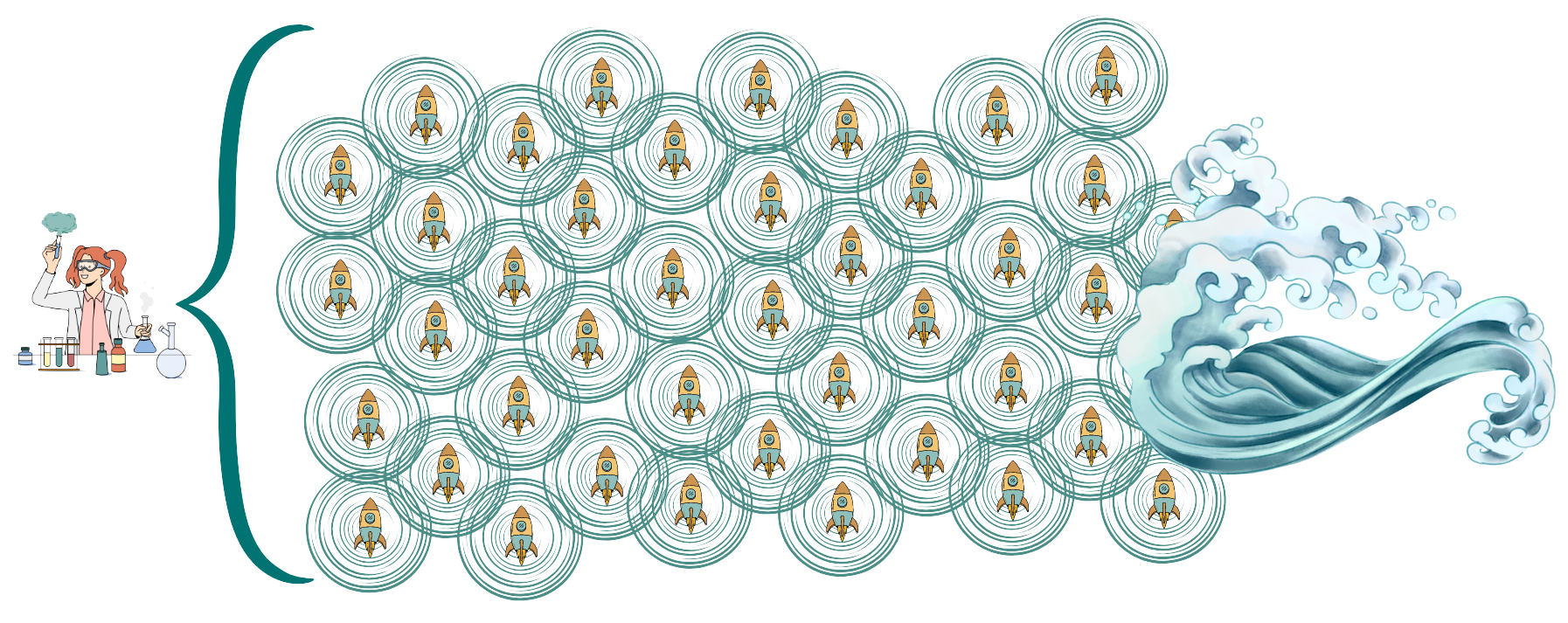
THE TRUTH IS:
You can make waves of change
with just ONE add-on to your service business.
The Catalytic Change Model
We've developed a research-backed model for making catalytic change as a service or support organisation that want to make large-scale change and accelerate sector development to create the paradigm shift we urgently need.
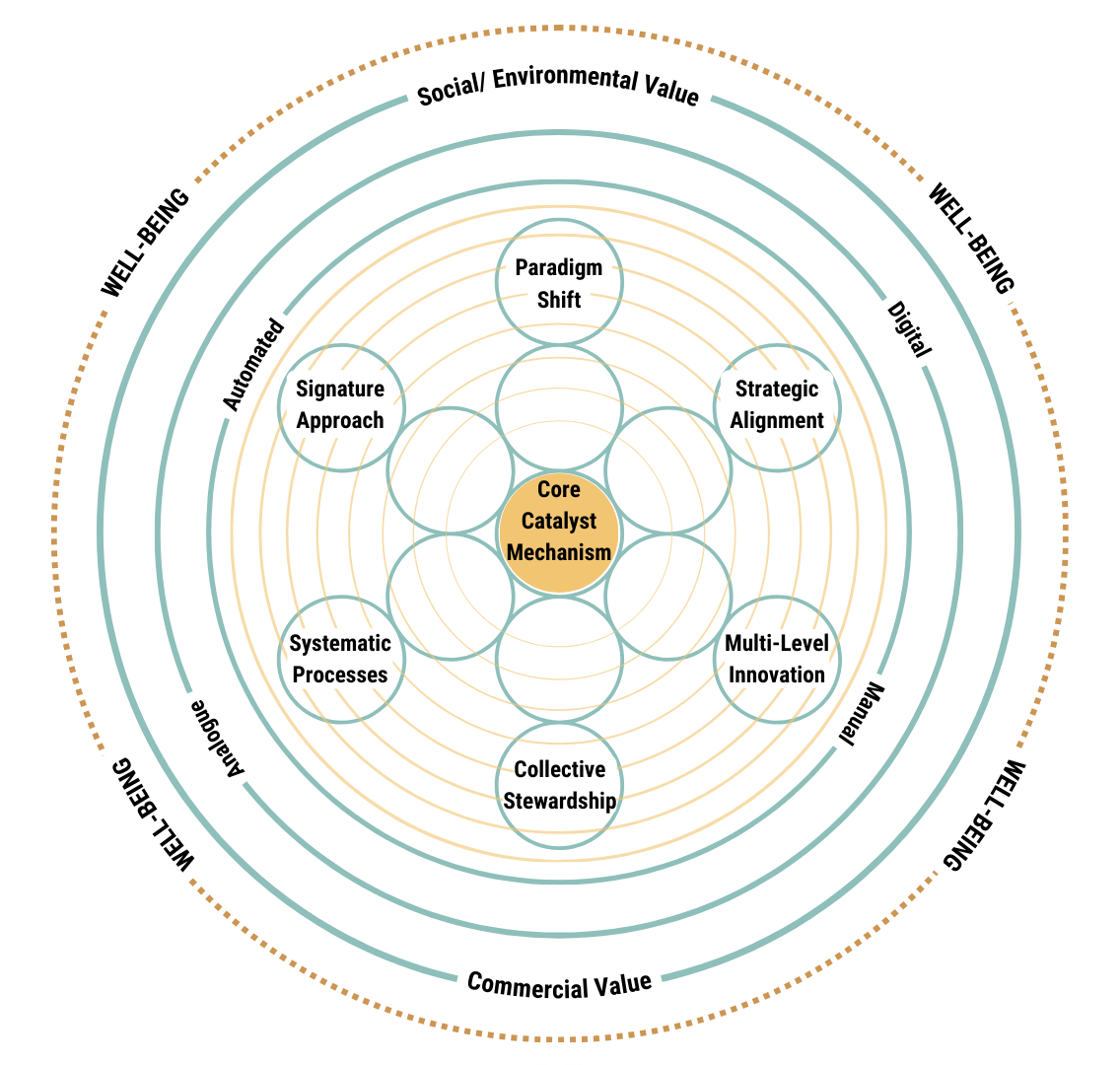
It requires a development from 'traditional' service-based business to becoming an Impact Sector Catalyst.
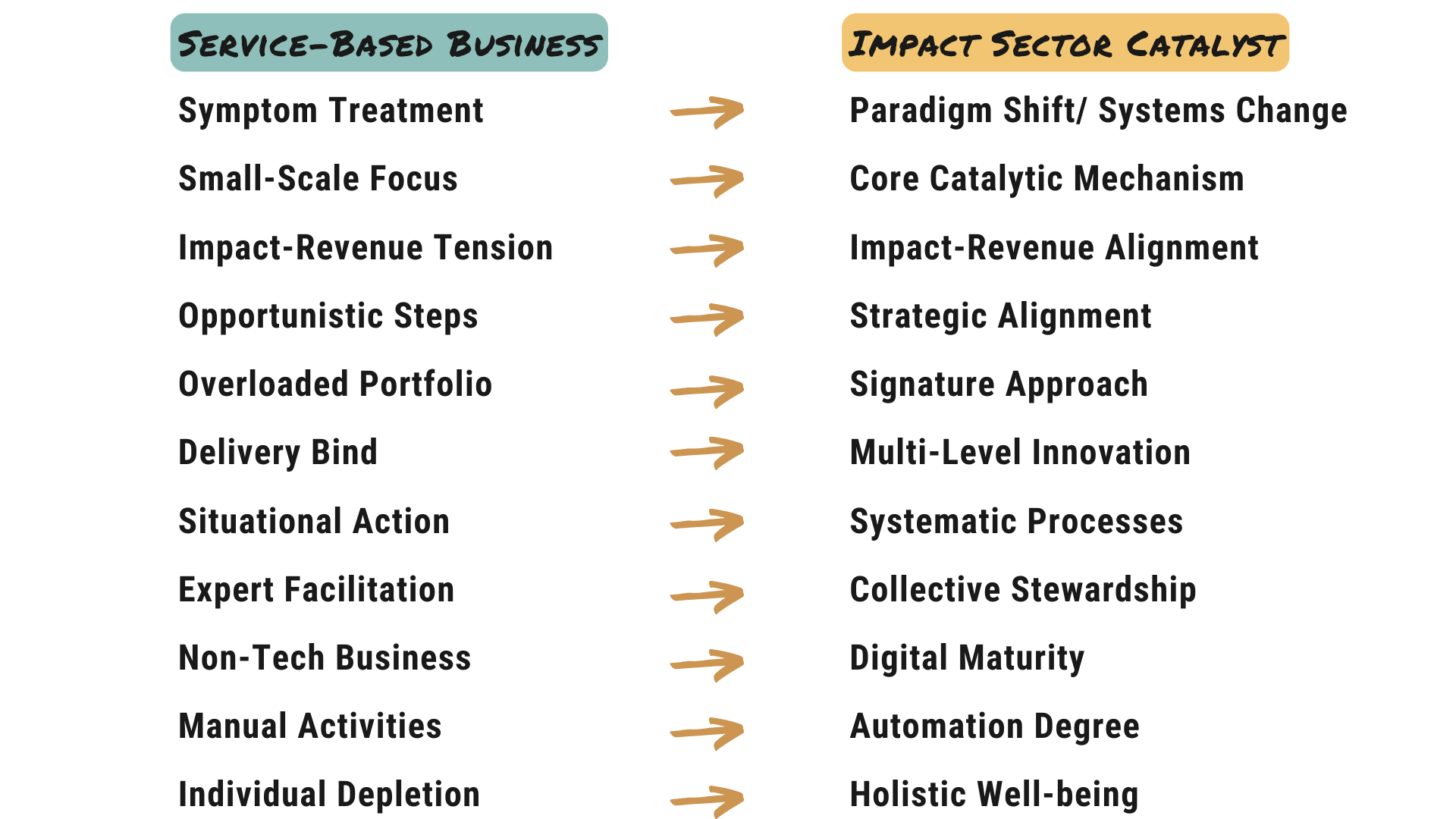
IT'S UP TO YOU:
You hold the strings to make big picture change and you can level up anytime.
Trigger Irreversible Tipping Points
Catalytic change does NOT depend on the size of your organisation or access to external funding. The opposite is true. You can be an Impact Sector Catalyst and address tipping points as a solopreneur or a medium-sized organisation.
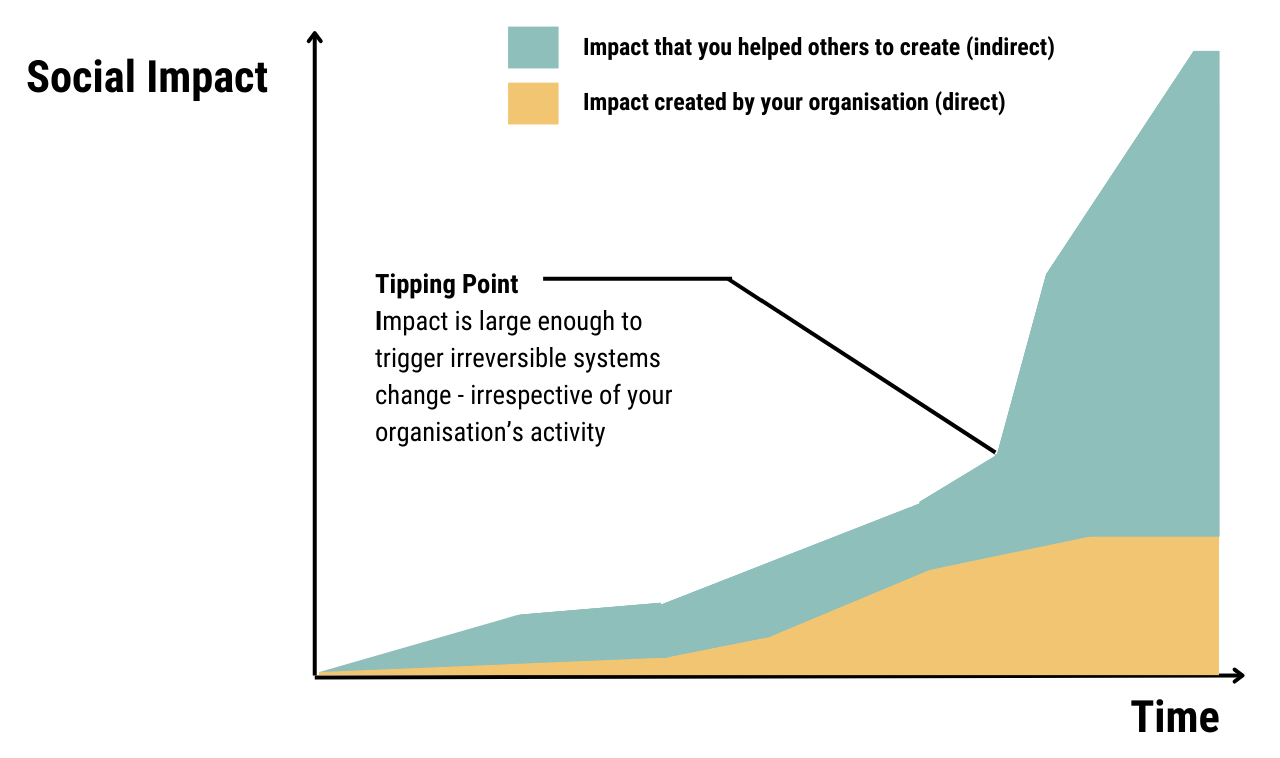
CHALLENGE YOURSELF:
You can tip the first domino to drive and contribute to systems change.
We Need To Blended Impact AND Revenue
By blending impact AND revenue generation (and profitability), you fund your own change changemaking efforts and scalable, catalytic action. This makes you independent of the goodwill of others. You build offers that deliver BOTH. With a blended offer you can cross-subsidise other activities/ offers, if needed.
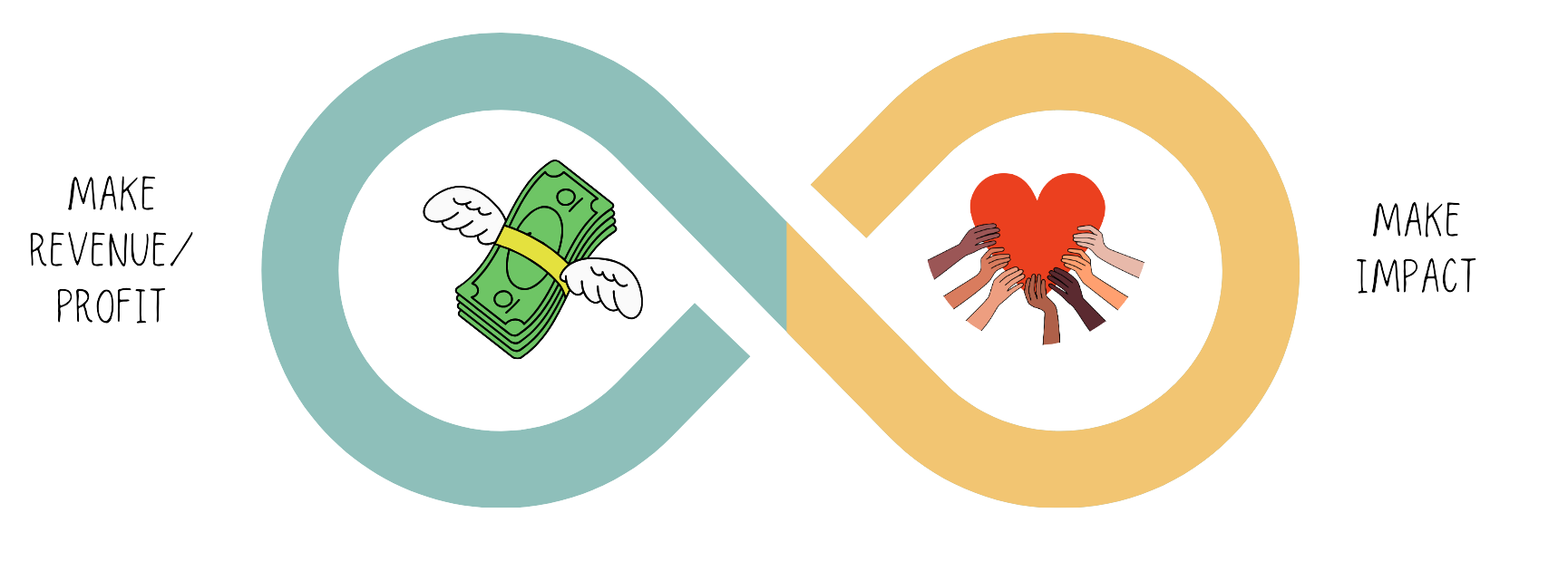
BLEND IT:
A healthy impact enterprise generates impact AND financial value and aligns them.
Blended Scale Of Impact AND Revenue
Designing for the scalability of both - impact and revenue/ profit - allows for large-scale change, even with a small team and little support. It decouples your outcomes from your time and number of people.
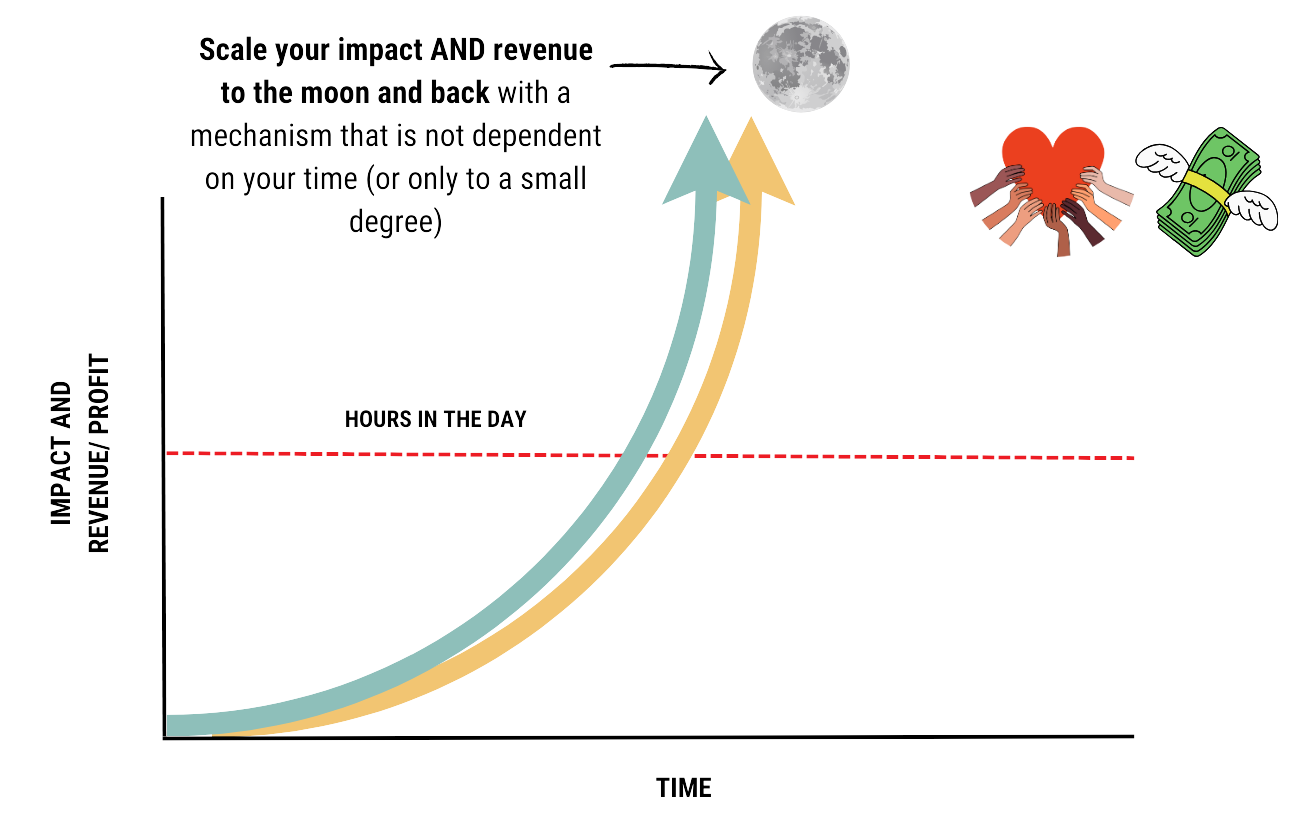
IT'S A CHOICE:
You can scale your impact and revenue to the moon and back.
Create Your Holy Cash Cow
The core catalytic mechanism (see framework above) is what we also call the Holy Cash Cow. It is an animal that is hard to spot if you don't know where to look, but we offer amazing support for you to find and nurture the Holy Cash Cow in your service or support business. 😉

THIS IS WILD:
The Holy Cash Cow is the spirit animal of impact-driven service and support organisations.
How We Support You
Learn how to make catalytic change as an impact-driven service and support organisation and how it applies to you. Full access to the framework! FREE right now.
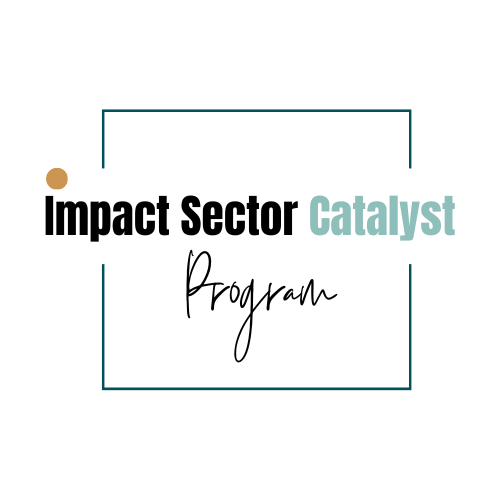
Build a catalytic mechanism into your business in 12 months so that you can generate impact and revenue at scale and create a large scale ripple effect in many years to come.
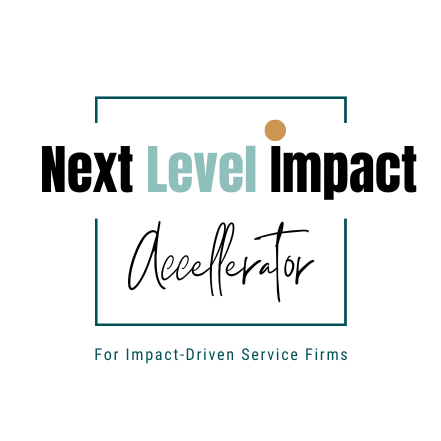
Meet Judith
Judith Hartlmaier,
Founder of Positive Impactpreneur
Judith is your guide to your next-level impact service firm to multiply your impact AND revenue so that together we can shape a new paradigm in business and the economy.
She has created impact-focused brands and programs in various sectors and has an extraordinary and unique perspective on how to do business as a force for good. She combines experience and expertise from business and entrepreneurship, management consulting and the corporate world, education and learning design, the arts, creativity and innovation, as well as digital business model design and product/ service development with a planet-centric perspective. Judith works in an international and highly diverse setting with a strong focus on blending purpose and profitability. She is a real pro at helping people grow beyond what they think possible. Creating meaningful learning experiences is her jam.


